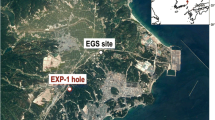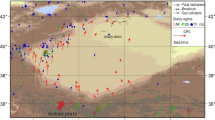Abstract
Hydraulic fracturing is one of the best-known methods of in situ stress measurement at great depths. In the last two decades, this method has been used as an important tool for pre-excavation designing of large projects, e.g., hydroelectric power plants, tunnels, mines, waste disposal galleries, etc. In this paper, some methods of stress calculation in fractured and intact rocks by means of hydraulic fracturing test are described, and the in situ stress states of Aras hydropower project and Roudbar Lorestan pumped-storage project are determined afterwards. The hydraulic fracturing (HF) and hydraulic tests on preexisting fractures (HTPF) tests were carried out in four vertical boreholes at shallow depth (100–190 m) at Aras and two vertical boreholes at almost great depth (440–520 m) at Roudbar Lorestan. The in situ stress magnitudes and orientations are calculated by classical and inversion methods in HF method (great depths) and by differential evolution and Gauss–Newton algorithms in HTPF method (shallow depths). The results of stress measurements illustrate that differential evolution provides better solutions than Gauss–Newton method. It is also demonstrated that the maximum horizontal stress orientation falls in southeast quarter which is in good agreement with the reports published from focal mechanism analysis and the direction of existing faults in Aras Project but deviates from world stress map data in the Rudbar site where it is influenced by the local joints and fractures in the test zone. Eventually, it should be mentioned that the ratio of horizontal to vertical stresses is significantly affected by topography and geology of the test areas. However, this ratio decreases as the depth increases.













Similar content being viewed by others
References
Aadnøy BS (1990a) Inversion technique to determine the in-situ stress field from fracturing data. J Pet Sci Eng 4:127–141
Aadnøy BS (1990b) In-situ stress directions from borehole fracture traces. J Pet Sci Eng 4:143–153
Amadei B, Stephansson O (1997) Rock stress and its measurement. Springer
Baumgärtner J, Rummel F (1989) Experience with “fracture pressurization tests” as a stress measuring technique in a jointed rock mass. Int J Rock Mech Min Sci 26:6
Burlet D, Cornet F, Feuga B (1989) Evaluation of the HTPF method of stress determination in two kinds of rock. In: International Journal of Rock Mechanics and Mining Sciences & Geomechanics Abstracts, Elsevier
Bradley WB (1979) Failure of inclined wellbores. J Energy Res Tech Trans AIME 102:232–239
Brown ET, Hoek E (1978) Trends in relationships between measured rock in situ stresses and depth. Int J Rock Mech Min Sci Geomech Abstr 15:211–215
Cornet FH, Valette B (1978–2012) In situ stress determination from hydraulic injection test data. J Geophys Res Solid Earth 89. B13(1984): 11527–11537
Cornet F, Julien P (1989) Stress determination from hydraulic test data and focal mechanisms of induced seismicity. In: International Journal of Rock Mechanics and Mining Sciences & Geomechanics Abstracts, Elsevier
Cornet FH (1993) Stresses in rock and rock masses. In: Hudson JA (ed) Comprehensive rock engineering, 3. Pergamon, Oxford, p 310
Djurhuus J, Aadnoy BS (2003) In situ stress state from inversion of fracturing data from oil wells and wellbore image logs. J Pet Sci Eng 38:121–130
Fairhurst C (1964) Measurement of in-situ rock stresses with particular reference to hydraulic fracturing. Rock Mech Eng Geol 2:129–147
Fairhurst C (1968) Methods of determining in-situ rock stresses at great depth. TRI-68 Missouri River Div, US Army Corps of Engineers
Gjønes M, Cruz AMGL, Horsrud P, Holt RM (1998) Leak-off tests for horizontal stress determination. J Pet Sci Eng 20:63–71
Haimson B (1993) The hydraulic fracturing method of stress measurement: theory and practice. In: Hudson JA (ed) Comprehensive rock engineering, 3. Pergamon, Oxford, pp 395–412
Haimson B, Cornet FH (2003) ISRM suggested methods for rock stress estimation—part 3: hydraulic fracturing (HF) and/or hydraulic testing of pre-existing fractures (HTPF). Int J Rock Mech Min Sci 40:1011–1020
Haimson B, et al (1993) Estimating the state of stress from subhorizontal hydraulic fractures at the underground research laboratory, Manitoba. In: International Journal of Rock Mechanics and Mining Sciences & Geomechanics abstracts
Heidbach O, Tingay M, Barth A, Reinecker J, Kurfeß D, Mu¨ller B (2010) Global stress pattern based on the World Stress Map database release 2008. Tectonophysics 482:3–15
Huang J, Griffiths DV, Wong S-W (2011) In situ stress determination from inversion of hydraulic fracturing data. Int J Rock Mech Min Sci 48:476–481
Hubbert MK, Willis DK (1957) Mechanics of hydraulic fracturing. Trans AIME 210:153–163
IWPCO (2007) The geological engineering and rock mechanics report, Aras Hydro-power project. Iran Water and power Resources Dev. Company, Iran
Kirsch G (1989) Die theorie der elastizit ¨at und die bed ¨ urfnisse der festigkeitslehre. Z Ver Dtsch Ing 42:797–807
Ljunggren C, Raillard G (1987) Rock stress measurements by means of hydraulic tests on pre-existing fractures at Gideå test site, Sweden. Int J Rock Mech Min Sci Geomech Abstr 24:6
Mahab Ghods Consulting Engineers (2013) Seismic hazard evaluation and seismic design criteria, Rudbar Lorestan pumped storage project, Iran; Iran Water and Power Resources Dev. Company
MeSy-Solexperts Gmbh (2013) Report on hydraulic fracturing stress measurement, Roudbar Lorestan pumped storage project, Iran; Iran Water and power Resources Dev. Company
Price KV, Storn RM, Lampinen JA (2005) Differential evolution a practical approach to global optimization
Stephansson O, Zang A (2012) ISRM suggested methods for rock stress estimation—part 5: establishing a model for the in-situ stress at a given site. Rock Mech Rock Eng 45:955–969
Storn R, Price K (1996) Minimizing the real functions of the ICEC'96 contest by differential evolution. In: Evolutionary Computation
Tarantola A, Valette B (1982) Generalized nonlinear inverse problems solved using the least squares criterion. Rev Geophys 20(2):219–232
Zang A, Stephansson O (2010) Stress field of the Earth’s crust. Springer Science and Business Media BV, Dordrecht
Author information
Authors and Affiliations
Corresponding author
Rights and permissions
About this article
Cite this article
Talebi, M.H., Heidari, S., Moosavi, M. et al. In situ stress measurements of two hydropower projects in Iran by hydraulic fracturing method. Arab J Geosci 8, 7073–7085 (2015). https://doi.org/10.1007/s12517-014-1676-4
Received:
Accepted:
Published:
Issue Date:
DOI: https://doi.org/10.1007/s12517-014-1676-4




